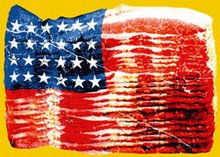The Khuzestan Gambit
 The Chess Match: The battle between good and better by Kenneth Graunke
The Chess Match: The battle between good and better by Kenneth Graunke
I stumbled over this at Global Security and thought it was quite informative. I especially liked this:
The term gambit comes from the Italian word gambetto, which was used for a tricky manoeuvre in wrestling. A chess gambit is a exotic way to enjoy a chess game -- there is a touch of recklessness necessarily to become a gambiteer. The term gambit applies to the opening of the game, involving an early sacrifice to achieve later superior attacking chances. The sacrifice is usually speculative, but hard to refuse.Just imagine it. The UN is dithering. The no-good, leftist apparatchnik of the US is screaming. The Iranians are getting all jacked up in a religious frenzy. Sanctions are being threatened. Oil prices are going through the roof. Financial Markets are getting pounded. The Iranians are jawboning about cutting off their oil production. The situation is dire and getting worse.
Well, what about the Khuzestan Gambit?
Khuzestan [Khouzestan] is the most important pivot of Iran's economy. The existence of such huge resources as oil, gas and water in Khuzestan have changed the economic appearance of Iran. Oil first erupted from a well in the Massjed e Soleyman area, located in the southern Khuzestan province.More from Global Security about the region:
The vast majority of Iran's crude oil reserves are located in giant onshore fields in the southwestern Khuzestan region near the Iraqi border and the Persian Gulf. Iran has 32 producing oil fields, of which 25 are onshore and 7 offshore. Major onshore fields include the following: Ahwaz-Asmari (700,000 bbl/d); Bangestan (around 245,000 bbl/d current production, with plans to increase to 550,000 bbl/d), Marun (520,000 bbl/d), Gachsaran (560,000 bbl/d), Agha Jari (200,000 bbl/d), Karanj-Parsi (200,000 bbl/d); Rag-e-Safid (180,000 bbl/d); Bibi Hakimeh (130,000 bbl/d), and Pazanan (70,000 bbl/d). Major offshore fields include: Dorood (130,000 bbl/d); Salman (130,000 bbl/d); Abuzar (125,000 bbl/d); Sirri A&E (95,000 bbl/d); and Soroush/Nowruz (60,000 bbl/d).Semper Fi! Carpe Diem! It's good to be the only remaining Superpower!
According to the Oil and Gas Journal (1/1/04), Iran holds 125.8 billion barrels of proven oil reserves, roughly 10% of the world's total, up from 90 billion barrels in 2003. In October 1999, Iran announced that it had made its biggest oil discovery in 30 years, a giant onshore field called Azadegan located in the southwestern province of Khuzestan, a few miles east of the border with Iraq. Reportedly, the Azadegan field contains proven crude oil reserves of 26 billion barrels. In July 2004, Iran's oil minister stated that the country's proven oil reserves had increased again, to 132 billion barrels, following new discoveries in the Kushk and Hosseineih fields in Khuzestan province.
Iran's energy generation capacity has risen to about 26,000 megawatts. The share of Khuzestan in total amount of energy produced in the country was 3,800 mega watts. The figure is expected to increase following operationing of three dams in Khuzestan province. Water resources are unevenly spread; 30 percent of surface water resources are concentrated in one province (Khuzestan), while many other populated provinces fully exploit their scarce available resources.
Let's see, we could use our military footprint in Iraq to pursue the Khuzestan Gambit by staging a raid into Khuzestan to seize the oil fields. A blockade of the ports would further increase the pressure. It is rumored that their central bank would run out of money in three weeks. The mullahs just might become more amenable when the only thing they have to eat is oil.
Remember Kuwait people. Oil disruptions take many forms and I wouldn't put it past old AlmondJoy to light 'em up in a fit of starved pique. In this case it would be peace for oil. Hey, I like that - you give us peace, we give you oil.
Do we have the stones for something like the Khuzestan Gambit?
The Zagros Mountains form a natural pallisade defending Iran from incursions from Iraq. The Iranian province of Khuzestan is the one large piece of flat Iranian terrain to the west of the Zagros Mountains. American heavy forces could swiftly occupy Khuzestan, and in doing so seize control of most of Iran's oil resources, and non-trivial portions of the country's water supply and electrical generating capacity.
I pray we do.





|